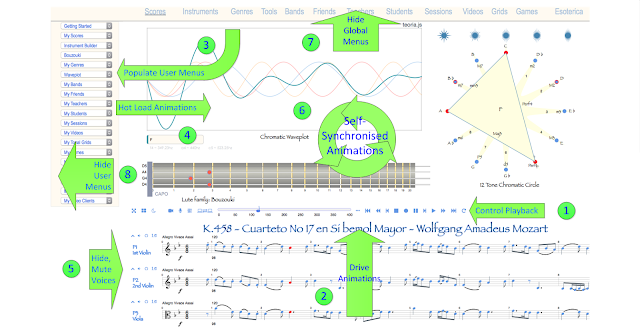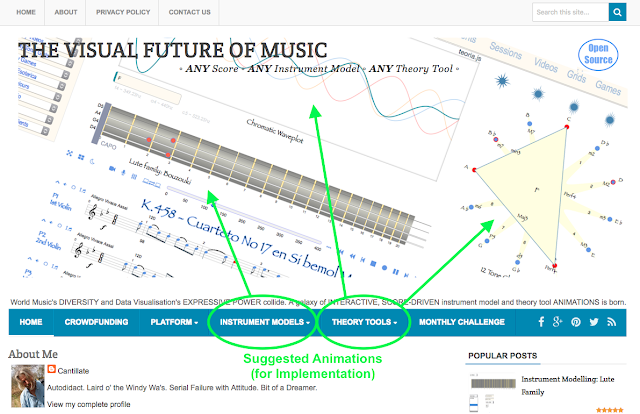Highly interactive, hot-loadable, on-screen configurable, score-driven animations - synchronised with music notation in a customisable, in-browser environment?
How's that supposed to work?
Big, brave, open-source, non-profit, community-provisioned, cross-cultural and sonic the hedgehog crazy. → Like, share, back-link, pin, tweet and mail. Hashtags? For the crowdfunding: #VisualFutureOfMusic. For the future live platform: #WorldMusicInstrumentsAndTheory. Or simply register as a potential crowdfunder..
How Does It All Work Together?
By now you will probably have come across several screenshots of the world music aggregator platform's user interface, and possibly have been lucky enough to stumble across the odd video.

Magick!
It may, nevertheless, still be a little unclear how all this hangs together.
Keeping in mind that the aggregator platform and this blog are entirely separate entities, once again, a diagram to the rescue... Read on.
The Aggregator Platform
In a not-too-distant future, our world music aggregator platform will allow users to select and populate their environment from amongst thousands of fully-dynamic, interactive, score-driven instrument models and theory tools spanning the entire treasury of world and experimental music.
Each family of animations will be built from a generic base, meaning that under progressive application of each of the entire range of configuration possibilities, any generic base may yield hundreds of individual instrument configurations.
To get started, let's assume a score has been loaded from one of the many online repositories worldwide.
On playback, the score is used to drive a number of animations user-selected from menus (LHS) which have been populated from global classification trees situated along the top of the interface:

Music Visualisation Aggregator Platform Nitty Gritty
For these behaviours to continue to work in the long run will require close attention to some simple, well established programming and integration conventions. Publishing these is one of the goals of the crowdfunding project.
If you know where to look, however, many future features are already described within this blog - not in the sequential posts list, but under the banner menus.
This Blog

The blog is initially intended as a catalyst or springboard for the world music aggregator platform crowdfunding initiative, providing insights into it's main goals and progress, plus (banner menus) longer-term goals.
On completion of the initial crowdfunding, it will be cleaned up and used to track subsequent rounds. I'm new to blogging and time is short, so please be patient with the many formatting niggles.
Banner Menus
On being published, every chronological post is subsequently linked to from one of the main menus. The most prolific linking is within the 'Platform' menu.
Should the chronological posts seem a little unmanageable over time, their content can still be found either within the corresponding menu tree, or by using the search field.
The Crowdfunding menu item is a currently a staging area for thoughts on the campaign, but will later track crowdfunding progress for blog readers (as opposed to campaign supporters).

 Aside from chronological post and the Project menu, the blog's most prominent features are the menus covering Instrument Models and Theory Tools. These reflect, in much simplified form, the implementation goals of the platform in the near future.
Aside from chronological post and the Project menu, the blog's most prominent features are the menus covering Instrument Models and Theory Tools. These reflect, in much simplified form, the implementation goals of the platform in the near future.
Many other features (user accounts, genres, teachers, events etc) are planned, but these are all dependent on a thunderingly successful initial crowdfunding.
It is well worth looking through each of these menus, as their content gives a far closer impression of the future range of instrument models and theory tools than is available from the blog posts.
We are talking of literally thousands of instrument models and scores of theory tools, each dynamically linked to provide continuously-configurable and compatible visual continuum.
This is not rocket science, but will require discipline. With community help and standard, proven interfaces available via template to all future instrument models and theory tools, however, I firmly believe the goals to be realistic and achievable.
At the end of the day, we will have an aggregator platform spanning the entire breadth of world music instrumentation and theory, and lending itself to being driven by a variety of sources. It will provide the technical base for online, P2P teaching - worldwide.
The internet has become a vast, riotous jungle. Breaking through the dense undergrowth and getting heard is challenging. Even after many months of blogging, page visits remain low.
If this project's social potential excites you as it does me, please help spread the word.
Tweet, email, share, blog and amplify into your follower trees. Backlink where you can.
Use the HTML Cheat Sheet for color picker, search for special HTML characters, get examples of the most common tags and generate any tags.
Keywords
online music learning,
online music lessons
distance music learning,
distance music lessons
remote music lessons,
remote music learning
p2p music lessons,
p2p music learning
music visualisation
music visualization
musical instrument models
interactive music instrument models
music theory tools
musical theory
p2p music interworking
p2p musical interworking
comparative musicology
ethnomusicology
world music
international music
folk music
traditional music
P2P musical interworking,
Peer-to-peer musical interworking
WebGL, Web3D,
WebVR, WebAR
Virtual Reality,
Augmented or Mixed Reality
Artificial Intelligence,
Machine Learning
Scalar Vector Graphics,
SVG
3D Cascading Style Sheets,
CSS3D
X3Dom,
XML3D
ANY: Music System ◦ Score ◦ Voice ◦ Instrument Or Theory Tool Config ◦
World Music's DIVERSITY and Data Visualisation's EXPRESSIVE POWER collide. A galaxy of INTERACTIVE, SCORE-DRIVEN instrument model and theory tool animations is born.
Entirely Graphical Toolset Supporting World Music Teaching & Learning Via Video Chat ◦ Paradigm Change ◦ Music Visualization Greenfield ◦ Crowd Funding In Ramp-Up ◦ Please Share
Featured Post
All Posts (*** = Recap)
- User Environment - Preferences and Population
- Comparative Musicology & Ethnomusicology
- Music Visualisation - a Roadmap to Virtuosity ***
- A Musical Instrument Web Repository
- Toolset Supported Learning Via Video Chat
- Key Platform Features ***
- Platform Aspirations
- Aggregator Platform vs Soundslice
- Music, Machine Learning & Artificial Intelligence
- World Music Visualisations And The 3D Web
- Cultivating Theory Tool Diversity
- Cultivating Instrumental Diversity
- Cultivating Notation Diversity
- Cultivating Music System Diversity
- One URL To Animate Them All And In The Browser Bind Them ***
- Music Visualisation: Platform Overview
- Music Visualisation: Challenges
- Music Visualisation: The Key To Structure
- Music Visualisation: Motivation ***
- Music Visualisation: Key Concepts ***
- Music Visualisation: Social Value
- Music Visualisation: Prototype
- Music Visualisation: Catalysts
- Music Visualisation: Platform Principles
- Music Visualisation: Here Be Dragons
- Music Visualisation: Potential
- Music Visualisation: The Experimental Edge
- Music Visualisation: Business Models
- Music Visualisation: Technical Details
- Music Visualisation: (Anti-)Social Environment
- Music Visualisation: Arts, Crafts, Heritage
- Music Visualisation: Politics
- Music Visualisation: Benefits ***
- PROJECT SEEKS SPONSORS
- Consistent Colour Propagation
- Orientation: Genre-Specific Workflows
- P2P Teacher-Student Controls
- Musical Modelling
- Social Media Integration
- Platform Provisioning In Overview
- Generic to Specific Modelling: A Closer Look
- Notation, Standardisation and Web
- Communication: Emotional vs Technical
- Musical Storytelling
- Product-Market Fit
- Monthly Challenge
- World Music Visualisations and Virtual Reality
- World Music Visualisations: Paradigm Change?
- How Does It All Work Together?
- Off-the-Shelf Animations: Musical Uses
- MVC vs Data Driven
- A Reusable Visualisation Framework
- What IS Music Visualisation?
- Questions Music Visualisations Might Answer
- Google Group for World Music Visualisation
- Instrument Visualization: Fingering Controls
- Static, Active, Interactive, Timeline-Interactive
- Visualising Instrument Evolution
- Unique Social Value (USV)
- Instrument Modelling: Lute Family
- Person-to-Person ('P2P') Music Teaching
- Alternative Music Visualizer Scenarios
- Music Visualisation: Why a platform, not just an app?
- Music, Dance and Identity: Empowerment vs Exploitation
- Why No Classification System For Music Theory?
- Musical Heritage, Copyright and Culture
- Visualisation Aggregator Platform - Musical Immersion
- Instrument Models - Complete Configuration Freedom
- Diversity is Health, Contentment is Wealth
- Politics & Provisioning Mechanisms of World Music Learning
- Technology, Tribes, Future and Fallout
- Rule-Based vs Data-Driven Notation
© Copyright 2015 The Visual Future of Music. Designed by Bloggertheme9 | Distributed By Gooyaabi Templates. Powered by Blogger.

Comments, questions and (especially) critique welcome.